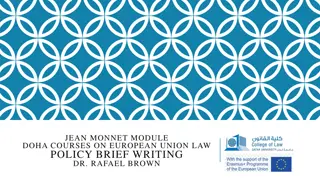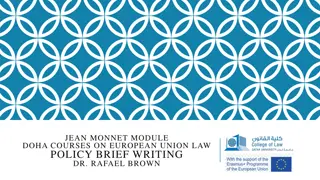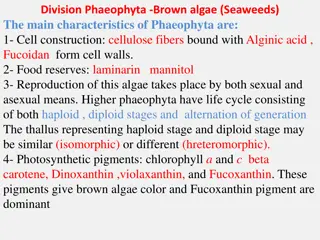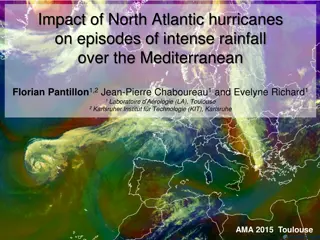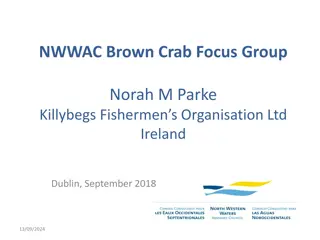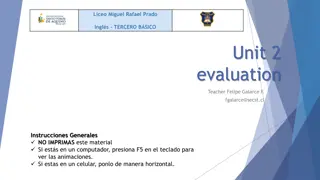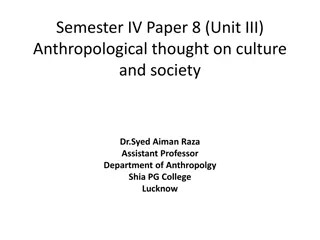DR. RAFAEL BROWN
EU Law Directive 2008/99/EC protects the environment through criminal law by defining serious offences harming the environment. It mandates EU countries to impose effective penalties for harmful actions, including discharging dangerous materials, handling hazardous waste, and operating risky industrial plants. The directive also holds legal persons accountable for offences committed for their benefit. It builds upon Directive 2004/35/EC on environmental liability and places responsibility on EU countries to prosecute environmental crimes efficiently.
Download Presentation

Please find below an Image/Link to download the presentation.
The content on the website is provided AS IS for your information and personal use only. It may not be sold, licensed, or shared on other websites without obtaining consent from the author.If you encounter any issues during the download, it is possible that the publisher has removed the file from their server.
You are allowed to download the files provided on this website for personal or commercial use, subject to the condition that they are used lawfully. All files are the property of their respective owners.
The content on the website is provided AS IS for your information and personal use only. It may not be sold, licensed, or shared on other websites without obtaining consent from the author.
E N D
Presentation Transcript
JEAN MONNET MODULE FALL 2023 DOHA COURSES ON EUROPEAN UNION LAW DR. RAFAEL BROWN
General EU Environmental Issues Course 2, Module 1 Class 9
EU Law Against Environmental Crime Directive 2008/99/EC protecting the environment by means of criminal law. It defines a number of serious offences that harm the environment. It requires EU countries to introduce effective and proportionate penalties constituting a deterrent for such offences, regardless of whether they are committed intentionally or through serious negligence.
Key Points Types of unlawful behaviour harmful to human health or the environment that are subject to penalties include: - Discharging, emitting or otherwise releasing dangerous materials into air, soil or water; - Collecting, transporting, recovering or disposing of hazardous waste; - Shipping noticeable quantities of waste; - Operating an industrial plant that conducts dangerous activities or stores dangerous substances (e.g. factories producing paints or chemicals); - Manufacturing, treating, storing, using, transporting, importing, exporting, or disposing of nuclear material and hazardous radioactive materials;
Penalties EU countries must ensure that the offences or types of unlawful behaviour listed in Article 3 of the Directive are punishable by effective and proportionate criminal penalties constituting a deterrent and applicable to individuals. EU countries must establish that legal persons can be held liable for offences committed for their benefit by persons acting in a leading position based on a power of representation, on an authority to take decisions on behalf of the legal person or to exercise control within the legal person.
Penalties Liability of legal persons does not exclude criminal proceedings against natural persons who are perpetrators, inciters or accessories in the offence referred to in the Directive. Depending on the legal system applicable in the EU country concerned, the liability of legal persons may be criminal or non-criminal. This directive builds upon Directive 2004/35/EC, which lays down rules on environmental liability as regards preventing and remedying environmental damage.
Penalties EU countries are responsible for prosecuting environmental crime. Because legal systems differ among EU countries, criminals can exploit any lack of cooperation and coordination between national authorities. Networks of environmental professionals, such as the EU Network for the Implementation and Enforcement of Environmental Law (IMPEL), the EU Forum of Judges for the Environment (EUFJE) and the European Network of Prosecutors for the Environment (ENPE), play an important role in sharing best practice and developing methodologies for effective enforcement.
Environmental Agencies & Bodies
The EUs Environment Agency - Environmental Information and Monitoring The regulation describes the aims and objectives of the European Environment Agency (EEA) and the European Environment Information and Observation Network (EIONET). This enables them to provide information in support of the formulation of EU environmental policy. The EEA is an EU agency whose objective is to protect and improve the environment and support sustainable development.
The EUs Environment Agency - Environmental Information and Monitoring It does this by providing objective, reliable and comparable information so that: - Measures are taken to protect the environment; - The results of such measures are assessed; - The public is kept informed about the state of the environment; - EU countries have the necessary technical and scientific support.
The EUs Environment Agency - Environmental Information and Monitoring It has the following principal tasks: - To collect, process and analyse data to provide the EU with the objective information necessary for effective environmental policies; - To assist the monitoring of environmental measures; - To collate, assess and disseminate data on the state of the environment to the general public; - To ensure that data are comparable Europe-wide;
The EUs Environment Agency - Environmental Information and Monitoring - To promote the incorporation of EU data into international monitoring programmes such as those of the United Nations; - To stimulate the development of methods of assessing the cost of damage to the environment and the costs of preventive, protection and restoration policies; - To stimulate the exchange of information on the best technologies available for preventing or reducing damage to the environment; - To publish a report on the state of, trends in and prospects for the environment every 5 years.
The EUs Environment Agency - Environmental Information and Monitoring The data covered include: - Air quality and noise pollution; - Water quality; - State of the soil and of fauna and flora; - Land use and natural resources; - Waste management - Chemical substances; - Coastal and marine protection; - Climate change and adaptation to climate change.
The EUs Environment Agency - Environmental Information and Monitoring The EEA Board includes 1 representative from each of its member countries, 2 from the European Commission and 2 scientific experts appointed by the European Parliament. The EEA cooperates with other EU and international bodies, such as the EU s statistical office (Eurostat) and the European Commission's Joint Research Centre, the United Nations Environment Programme and the World Health Organisation. EIONET, coordinated by the EEA, is the EU s information network on environmental issues. It has representation from all EU countries, as well as Iceland, Liechtenstein, Norway, Switzerland and Turkey.
EU scientific committees on consumer safety (SCCS) & on health, environmental and emerging risks (SCHEER)
SCCS & SCHEER The role of the committees is: -To provide scientific opinions on risk assessment in the cases laid down by EU law; -To provide scientific advice to the Commission on questions of particular relevance to public health, consumer safety and environmental risks; -On invitation, to identify research needs to address critical information gaps, to assess proposed future research and to assess research results in relation to the subject areas in their domains; -To provide rapid risk advice on the state of scientific knowledge concerning specific risks in case they are urgent;
SCCS & SCHEER - To be part of thematic networks or events with other EU bodies or scientific organisations in order to monitor and contribute to the development of scientific knowledge in their fields of competence; - To draw the attention of the Commission and its services, through memoranda or position statements, to a specific or emerging problem which the committees consider may pose an actual or potential risk to consumer safety, public health or the environment; - To adopt their methodology for performing and providing risk assessment and keep it under review to reflect all relevant scientific factors, as well as ensure that it reflects current risk assessment practice.
SCCS & SCHEER Term of office: - The members of the committees are appointed for a 5-year term. - They remain in office until they are replaced or their appointment is renewed.
SCCS & SCHEER Independence - Members and external experts must act independently and in the public interest. - Members are nominated in a personal capacity; they cannot delegate their responsibilities to another person. - Declarations of interest must be made prior to appointment and then annually thereafter. - Members and external experts must declare at each meeting any specific interest which may compromise their independence in relation to items on the agenda.
European Pollutant Release and Transfer Register (E-PRTR) The regulation establishes the European Pollutant Release and Transfer Register (E-PRTR). This is a publicly accessible electronic database of key environmental data from industrial facilities in Europe. In 2019, Regulation (EC) No 166/2006 was amended by Regulation (EU) No 1010/2019 to align and streamline the reporting requirements in EU environmental legislation.
European Pollutant Release and Transfer Register (E-PRTR) Among other things, the amending regulation conferred powers on the European Commission to adopt implementing acts specifying the type, format and frequency of information to be reported under Regulation (EC) No 166/2006. Commission Implementing Decision (EU) 2019/1741 introduced changes specific to the E-PRTR further to Regulation (EU) No 1010/2019. The E-PRTR is available to the public free of charge on the internet. The information it contains can be searched using various criteria (type of pollutant, geographical location, affected environment, source facility, etc.).
Content of the E-PRTR The register contains information on releases of pollutants to air, water and land, as well as off-site transfers of pollutants present in waste-water and waste. The register covers 91 pollutants as listed in Annex II of Regulation (EC) No 166/2006, including greenhouse gases, heavy metals, pesticides, and chlorinated organic substances. Releases are required to be reported when they exceed a certain threshold and originate from one of the 65 activities listed in Annex I of Regulation (EC) No 166/2006.
Content of the E-PRTR The majority of these activities are also regulated under Directive 2010/75/EU on industrial emissions (see summary) and comprise, in particular, the facilities covered by the following sectors: - Energy production, - Production and processing of metals, - Mineral industry, - Chemical industry, - Animal and vegetable products from the food and beverage sector, and - Other activities e.g. producing textiles, leather tanning



